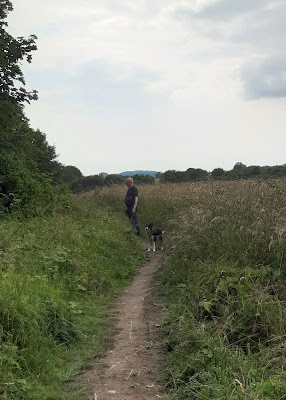Another factor in the not-going-anywhere at present is the football (and to a lesser extent, the tennis). Which is also scheduled to happen next summer too, but let's not gloom about that right now. So we're back in our fragile patch of edgelands, close to home but a world away from VAR. (And LFTs, and PCRS, B.1.617.2, and all other variants of SARS-COV-2, for that matter.)
Meanwhile, Charlton Common is boskier than ever. I read the other day that it's thought a herd of muntjac live on it. Not possible to know for sure because the scrub makes it inaccessible to humans.
The bit we walk on, that people think of and call the Common but is really a footpath running past the field formerly used by the people of Charlton* for sport, is more beautiful than ever, full of the song of skylarks and also now inaccessible to dog walkers and dogs. Or at least our dog, who sticks to running up and down the path. That it will be built on in the near future is almost unbearable to contemplate.
*The village razed in 1947 for the extension of the airstrip at Filton airfield
*The village razed in 1947 for the extension of the airstrip at Filton airfield
The small dark wood of the mind has had more light in it this year, on account of the hack-backery mentioned above. There was whitethorn in May and early June, and now there's honeysuckle, upright hedge-parsley and vetch, here with a very small and out-of-focus Common Carder bumble bee.
Though perhaps the best gift of the wood was hearing a tawny owl yesterday afternoon, which is all kinds of odd as we usually walk there in the evening and have never heard one. I had to wonder if it was the same bird that dropped a covert feather on top of some brambles where I found it last September, just after Ted had died. It did feel like a bit of a gift.
Elsewhere, on the common and in the field, there's been ...
Elsewhere, on the common and in the field, there's been ...
... red clover and vetch, what a combination of colour ...
... goat's-beard ...
... agrimony ...
... my favourite unumbellifer, yarrow ...
... ooh, and pink yarrow too, with creeping thistle and a ladybird ...
... mare's tail ...
... spear thistle ...
... opium poppy.
And later than last year, the wild carrots are donning their mad hats. I haven't seen any in the field yet, although being biennial, I don't suppose they'd necessarily be where they were last year. There were some on the Common, though, and on the golf course, near the pond, when we nipped across after all the golfers had gone home. (We do that sometimes. Shhh.)
The most common bumblebees we see are buff-taileds, which are very obliging at posing for photos ...
I've seen the occasional honey bee too ...
... and flies and hoverflies I don't know the names of, thick-legged flower beetles, and the first red soldier beetles of the season, having sex like there's no tomorrow. Which for them there might not be, and which is probably what oak trees think about us.
Most butterflies I've seen have been flapping around in that labour-intensive way they have, though a few did take the time to pose:
... small skipper, ringlet, meadow brown ...
I also spotted a cocchinella undecimpunctata larva, which will one day grow up to be an eleven-spotted ladybird but at the moment looks like something out of Dr Who.
The most amazing thing, though - and I am so sorry I have such a rubbish photo of it - was a white plume moth. Goodness, but it looks like a tiny, terrible angel of death. ('IT'S BEAUTIFUL! IT'S BEAUTIFUL!')
As for larger fauna, no deer to report lately, though we've seen rabbits and numerous foxes, of which I have just one terrible photo. Clue: it's running down the path, right in the middle of the photo.
Extremely tatty flight feather of a buzzard but no less beautiful for that
Flight feather of a magpie
When the full moon last rose, it was huge and orange in a way that doesn't really show in this photo ...
... but the sunsets have been incredible, not least because they have come on cloudy evenings that held out little promise. In fact, they became progressively Blakean.
I've been working very hard on my Creative Project for my MA, which is a sequence of poems about this place that is so precious to us, especially since we found it during this time of pandemic. I'm so thankful for the right of way that passes through it and that has made it accessible to us. It's a beaten path through a (mostly) unfrequented place and the chance of solitude during this time has been fantastic. I will go back to it and go back to it for the rest of my life.



















































What a lovely and detailed set of pics...always SO educational too!
ReplyDelete('probably what oak trees think about us..' hahaha)
To be honest, a tour of my brain probably isn't that educational. :-)
Delete